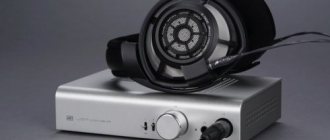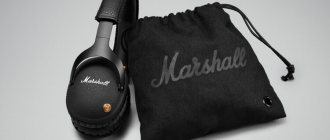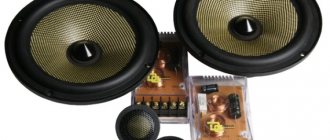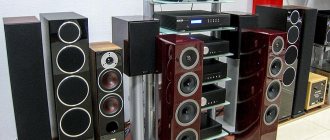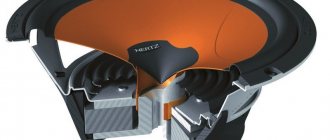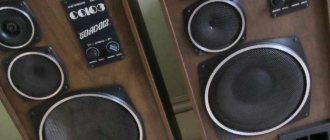Headphones are an essential item that gives you a chance to calmly do business or relax without disturbing others. “Ears” are needed for listening to audiobooks and music, watching movies and live communication via instant messengers or by phone. The wide range of applications has led to the release of models with different performance indicators. Therefore, when choosing, it is important to carefully study the technical characteristics of the headphones. Although the parameters specified by the manufacturer do not fully reflect the qualities that are important to users.
Main characteristics of headphones
To choose a suitable model, you need to pay attention to the purpose and design, as well as the characteristics that affect the sound quality. The latter include:
- sensitivity;
- reproducible frequency range;
- power;
- impedance (resistance);
But you should start your choice with general parameters: purpose and design. By purpose, there are two large groups:
- studio;
- household
The first is equipment for professionals and true music lovers; studio models provide full sound detail necessary for professional work with audio recordings. Such headphones are often chosen by music lovers, connoisseurs of sound with accurate reproduction of all nuances. Household models often distort the sound picture with “bulging” frequencies of the lower or upper spectrum.
Rating of the best professional headphones
Considering the method of pairing with the source, there are:
- wired, supplemented with a cable and connector for connecting to equipment - a computer, telephone, etc.;
- TWS, when using such models, the audio source communicates with the gadget via Bluetooth.
When purchasing wired headphones, you should take into account such an indicator as the length of the cable, and also check the availability of a 2.5 - 3.5 mm jack adapter. If this is a wireless model, then the primary characteristic is the wireless communication range.
The type of construction is the determining parameter of choice. The following models are available:
- intracanal, devices are inserted into the ear canal;
- in the form of earbuds placed in the ear;
- overhead, are flat ear pads
- full-size, covering the auricle.
Type of headphone design
Full-size models are available closed and open. The former do not allow sounds from the outside to pass through. The latter are equipped with holes that allow noise from the outside world to pass through.
Having decided on the design features of the model, you should move on to studying the technical indicators. Let's figure out what the characteristics of good headphones should be and how they affect quality.
Sensitivity
This is an indicator that determines the output acoustic pressure or, to put it more simply, the maximum undistorted volume of sound transmission. The unit of measurement is decibel (dB).
Sensitivity is determined by several parameters. The dimensions of the magnetic core have an influence; the larger this part, the louder the sound will be. As well as the core material, if neodymium magnets are used, then there will be a high degree of sensitivity even with compact sizes.
The standard sensitivity of headphones is within 90-120 dB, the indicators depend on the type of gadget. Thus, for in-ear models the sensitivity does not exceed 110 dB, in over-ear models this parameter reaches 120 dB, and in full-size models – up to 140 dB.
At a high level of sensitivity, the models play loudly when the volume level at the source is set within 50-60%. But if the sensitivity indicator is low, then you need to connect the gadget to initially powerful devices for playback.
However, the sensitivity value that the manufacturer indicates on the box is often formal. The parameter can be misleading as manufacturers use different testing methods. Data depends on:
- bench settings during testing;
- stage at which measurements were taken, some manufacturers indicate the value of testing only the speakers, and not the headphones assemblies.
If you take models with the same sensitivity values, but with different types of testing, then the testing results will not match.
Resistance has an additional effect on sensitivity. To achieve the same level of undistorted volume, high-impedance models require a higher output voltage than low-impedance models. Therefore, when choosing, you need to take into account the parameters of the sound signal to the headphones supplied from the source:
- smartphones and tablets provide an output voltage of 150-300 mV;
- standard players – 300 mV;
- computer and laptop – 300 mV (with a dedicated sound card, the voltage may be higher);
- TVs - 600-800 mV.
Therefore, it is necessary to pay attention to the ratio of sensitivity to voltage; this indicator is measured in dB/V. When specifying a parameter, a constant value of 1 V is taken for the output power. Thus, if the characteristics indicate a value of 130 dB/V, then with a resistance of 32 Ohms the operating value will be 105 dB.
The sensitivity should be selected based on the environment of use. “Quiet” models are also suitable for use at home, but for listening to songs on the street and in public transport, you need to choose an option with volume levels that drown out street noise.
Do not forget that frequent listening to audio at a volume level of 90 dB or more can negatively affect the ability to hear. And a sound with a volume of 145 dB causes concussion. Therefore, you need to choose headphones that are safe for your health.
frequency range
This is an indicator of the limits of the frequencies reproduced by the equipment. It should be understood that a wide range between the lower and upper limits is not always an indicator of sound quality.
The human hearing organs perceive sound at an oscillation frequency in the range of 20 - 20,000 Hz, but this interval is individual for each person. So, with age it narrows, people stop hearing the upper tones. Affects the ability to perceive sounds and place of residence. City residents, accustomed to noise, do not perceive sounds above 15,000 -17,000 Hz.
The frequency indicator of headphones is a formal parameter that is not capable of describing sound quality. What is important is not the reproduced range itself, but the volume of the sound. No brand has yet managed to ensure that the entire spectrum of sounds is broadcast at the same volume level. But the wider the spread between the boundaries, the smaller the fluctuations in amplitude-frequency characteristics in the lower part of the spectrum.
To understand how high quality the sound will be, you need to study the frequency response graph. When plotting:
- on the abscissa axis mark the frequency of the sound in Hz;
- on the ordinate - the sound volume in dB.
headphone frequency response graph
The graph shows what the tonal balance of the sound will be. They produce models with an emphasis on lower frequencies or higher sounds. At the boundaries of the range, the indicators will sharply decrease down to zero.
So, if a range of 5 - 25,000 Hz is specified, then the “sagging” of the sound will occur beyond the limits of audibility, that is, sounds audible to the human ear must be reproduced with the declared power level.
When studying characteristics, it is important to look not only at the frequency range, but also at the distortion factor in the speakers. This parameter is expressed as a percentage. The lower this indicator, the cleaner the sound will be.
Resistance (impedance)
Impedance is the total resistance received at the input of headphones. This value consists of active and reactive resistance, the unit of measurement is Ohm. The characteristic affects the sound volume and depends on the output power of the device. More information can be found here.
If the headphones will be used with a player, smartphone or compact laptop, then it is not rational to look for a model with a resistance of 50 Ohms. But to work with professional equipment, a high-impedance model is required.
Impedance does not affect the rate of battery discharge. The autonomy of the device is determined by the volume level, or more precisely, the power required to maintain a given volume level.
Manufactured headphones are usually divided into 2 types - low- and high-impedance. But the indicators for full-size and compact models are not the same. For small headphones, low-impedance headphones include options with an impedance of up to 32 Ohms, for large ones – up to 100 Ohms. Models with an impedance higher than these indicators are classified as high-resistance models.
If the headphone impedance seriously exceeds the recommended value, the amplifier will operate under increased load. This will cause distortion in sound quality or even lead to damage to either the amplifier at the sound source or the headphones themselves.
Impedance affects both volume and sound quality, but not directly, but in connection with other device parameters.
Maximum power
This indicator characterizes the upper level of power that is supplied to the headphones without the risk of damaging the device. This parameter is measured in mW.
The input power indicator is related to another parameter - sensitivity. The higher the sensitivity, the less power required to reproduce a given volume level.
⇡#Resistance
This is a pretty important parameter. If you are choosing headphones for your player, it would be a good idea to check what headphones impedance it is designed for. Typically, portable audio is designed to work with low-impedance headphones, which have an impedance of 32 ohms. But if you connect headphones with an impedance of 300 ohms to the player, this does not mean that you will not be able to hear the sound - they will just sound quieter. High-impedance headphones are rarely used; their resistance is measured in kilo-ohms.
What characteristics affect headphone volume?
Experienced users have more than once encountered a situation where some “ears” sound much louder than others, despite the fact that the level on the player did not change. A common belief is that this is due to the power of the model, but this is not entirely true. Yes, the more power, the stronger the sound, but sensitivity matters more for volume.
It is irrational to look for models with high power ratings if the headphones are planned to be used as a sound source from a smartphone or player. Using overly powerful headphones may result in poor sound quality as the source's built-in amplifier will not be able to handle the load.
The indicator that affects loudness is sensitivity. The higher the sensitivity value, the less load on the sound source. However, you should not rely only on the manufacturer’s information. Because users have noticed one feature: real sensitivity rarely coincides with that indicated on the box. Moreover, the lower the price of the model, the greater the likelihood that this discrepancy will be detected.
The problem is that testing standards have not been developed. Each manufacturer conducts tests according to its own rules, so the operating values of models with the same sensitivity may differ.
Are high ohms the best?
There is also a popular belief in the resistance of wired headphones that the higher it is, the better the sound. And behind this opinion there are sound notes - it is better to choose headphones with the highest possible impedance. However, you should immediately understand that the tighter the headphones you choose, the more powerful the source will be needed. In my memory, a person purchased 600 Ohm headphones, and then was very sad when he realized that they simply needed a rather expensive amplifier.
The output power of your smartphone (about 25 mW) is enough for a maximum of 64 Ohms. If the model has a resistance of more than 200 ohms, then it is advisable to have at least 200 mW of output power, and better yet 500. That is, immediately figure out what you will connect them to and whether your source will handle the selected model.
For smartphones, you should definitely stick to a reasonable maximum of 64 ohms. And even less is better. For the player and DAC, study their characteristics to understand whether it is enough or not.
From my own experience, anything above 200 Ohms requires an expensive player, an external amplifier, or even a completely stationary DAC. These headphones consume a fair amount of energy, so there’s not much to do with them in the portable segment.
What headphone parameters characterize sound quality?
All parameters influence the sound quality to some extent. But the most obvious one is the frequency range. The wider the range of reproduced frequencies, the richer the palette of sounds. Most manufacturers indicate on the box the standard range, within the ability of the human ear to perceive sounds, that is, 20 - 20,000 Hz. However, this characteristic does not sufficiently characterize the sound quality.
Rare manufacturers, in addition to standard figures, show an frequency response graph reflecting the operating picture. Thus, lower tones can be distinguished. But at such a volume level that they can only be heard in the sound chamber (acoustic room). You can't hear the bass on the street. Therefore, the frequency range indicated on the box is a convention.
Active Noise Cancellation
Modern problems require modern solutions, which is why both wired and wireless headphones are widely equipped with active noise cancellation. Is it convenient? - definitely yes, especially on the subway or plane. Another question is what happens to the quality of the music.
Usually all this is implemented by mixing a signal from a microphone in antiphase to it. That is, external noises seem to collapse, alas, with part of your music.
Consequently, active noise reduction is not about music addiction at all. And if all this happens in wireless headphones, where everything is far from ideal, then in the end we degrade the quality even more.
Although, there are times when necessity outweighs aesthetics and active noise reduction is still vital. See for yourself here.
Examples of technical characteristics of popular headphones
When choosing headphones, you must carefully study the information on the box and in the technical data sheet. It is important not only to read the brief description, but also to become familiar with the main characteristics that affect the sound.
Xiaomi Redmi AirDots
Xiaomi Redmi AirDots
A popular bluetooth headset model with reliable moisture protection. Pairs with Android and iPhone devices. The connection is made via Bluetooth 5.0, the range is up to 10 meters.
The following characteristics will help determine the sound quality:
- sensitivity – 98 dB;
- impedance – 32 Ohm;
- frequency – 20-20000 Hz.
The frequency response graph shows that in the lower range the bias is towards the mid-bass, but the low frequencies do not dominate. The HF quality is typical for headphones in the budget price segment, so it is unlikely that you will be able to enjoy the smallest nuances of sound, but this is unlikely when using compact wireless models
Judging by the reviews, there is enough volume reserve even when used outdoors. The advantage of the model is the absence of signal delay, which is often found in other budget wireless headphones.
Apple EarPods
Apple EarPods
A popular model of wireless headphones from Apple. The contours of the inserts are anatomically correct, even when worn during the day there is no discomfort.
Characteristics:
- sensitivity – 109 dB;
- reproduced frequency range – 20-20000 Hz;
- impedance – 23 Ohm.
A model with an open-type acoustic design; the earbuds are not equipped with sound insulation. This model is suitable for home and streets with traffic, since when listening to songs, external sounds are not suppressed, which will allow you to notice danger in time. But in public transport, headphones without noise reduction are uncomfortable; due to external noise, you will have to increase the volume, and this is harmful to the hearing organs.
According to information from the passport, the sensitivity of EarPod is 104.27 dB relative to power and 118.02 dB relative to voltage. The recommended source voltage level for this model is no less than 8.02 dBV at 42 Ohms for listening in a quiet room, and 3.98 dBV at a load of 42.21 Ohms for outdoor use.
The bass and lower midrange are in perfect order, but the upper midrange and notes in the upper register after 10 kHz are disappointing. Perhaps this was done to improve audibility during conversations, since the Apple EarPod is primarily a headset, and not headphones for music lovers.
JBL Tune 120 TWS
JBL Tune 120 TWS
JBL Tune 120 TWS is a wireless model that meets the brand's strict standards. The description states that the diameter of the model's driver is 5.8 mm, and JBL Pure Bass technology was used in its creation. Type of acoustic design – closed.
Characteristics:
- frequency range – 20-20000 Hz;
- sensitivity – 96 dB;
- resistance 14 ohms.
Frequency characteristics of the model with emphasis on the upper (above 10 kHz) and lower (70-12o Hz) frequencies. Tones below 70 Hz are less audible, and after 40 Hz there is a complete failure. The mid frequencies are also slightly overwhelmed, which negatively affects the sound quality.
A model with an increased level of sound insulation, external noise is muffled, you can use the earbuds in noisy environments without the need to increase the volume level. Even in public transport, 60-70% of the maximum volume level is enough to comfortably listen to songs without being distracted by external sounds.
Playback delay
The issue of playback delay occurs only in wireless headphones and often when they are used for games. Most good videos are dubbed, so the words don't end up in the actor's mouth. But for games this is really important.
But again, if you are going for a record, then no TWS will help you - use wires. And so, the more modern the codec, the lower the latency.
The exception is models with the so-called “game mode”, where they are reduced due to a shorter buffer. Just remember the dependence: lower latency means worse connection. Therefore, the game mode is not recommended for the street, and powerful modern codecs often switch to an adaptive communication mode themselves if there are problems.
conclusions
In conclusion, I would like to note that studying the characteristics is an essential, but not decisive, moment when choosing a model. Headphones of different brands with the same technical characteristics differ in volume and quality of the reproduced sound.
When listening, the impression is formed not only by these characteristics, but also by other indicators. No devices have yet been created that could perceive music the way a person can. The factor of subjective perception should be taken into account. This is easy to verify by studying customer reviews, when the same model is rated differently. Some users think the sound is suitable, while others think that the sound is no good.
Therefore, having selected models that are compatible with the sound sources used, they conduct tests, evaluating the sound personally. There is no other way to find sound quality acceptable for a particular user.
Summing up
The most optimal sensitivity of headphones is around 100±1%. And it is best for devices connected to mobile signal sources - smartphones and players.
Topic materials: 5 best JBL headphones
5 Best Bone Conduction Headphones
, 6 Best Headphones for Running , 6 Best Studio Headphones , 7 Best Denon Headphones
7 Best In-Ear Headphones
, 8 best armature headphones, 9 best Sennheiser headphones, How to choose headphones for listening to music on your phone and computer
Technical characteristics, general concepts
How are they different from full-size products?
Structurally - in size, since full-size headphones are made more thoroughly using expensive materials: genuine leather, metal, etc. The system for transmitting sound vibrations is also very different: for overhead ones, under the influence of electrical signals coming from the player or player, the membrane moves, due to which the sound is heard, and for full-size ones, high-quality speakers are installed, providing the product with full-fledged sound.
In addition, the ear pads create a certain space inside, which significantly increases the sound quality. The membranes of these products have a larger diameter, the dimensions of which reach up to 45 mm, and the larger the area, the better the low frequencies are reproduced, and its movement is carried out by a special coil. Therefore, music lovers prefer full-size headphones for the quality of materials and sound perception.
Selection rules
To choose among a large assortment of modern models the best on-ear headphones in all respects, you need to have a clear understanding of the main parameters, as well as determine in advance for what exact needs you are choosing the product. Don't look at the cost, which many consumers do, choose the type of device first.
It is the type that determines ease of use, and the sound quality greatly depends on it. Functional features are of no small importance, for example, Bluetooth (bluetooth - for those who do not know the correct pronunciation of this word), noise reduction systems, the presence of a standard “small Jack” connector and an adapter to a big Jack.
For wired over-ear headphones, the length of the wire is of great importance in order to ensure maximum comfort when working on a stationary PC, where the system unit is installed under the table and with a length of 1.5 meters the user will not be too comfortable. For wireless options, battery life without recharging is of great importance; for example, good and expensive models can work from 12 to 20 hours on a single battery charge.
There is no ideal option for all users in nature, because each individual has a different acuity of sound perception, so do not hesitate to check the product as much as possible on all parameters, try them on to feel the tightness of the ear pads. If this is not possible, because some products are sealed in plastic, then choose a well-known manufacturer of similar equipment that guarantees high quality and reliability.
Rating of the TOP 12 best on-ear headphones 2021-2022
| Place | Name | Price |
| TOP 6 best wired on-ear headphones | ||
| 1 | Sennheiser HD 300 Pro | Find out the price |
| 2 | Sony MDR-XB550AP | Find out the price |
| 3 | JBL T450 | Find out the price |
| 4 | Sony MDR-ZX660AP | Find out the price |
| 5 | Beats EP On-Ear | Find out the price |
| 6 | Xiaomi Mi Headphones Light Edition | Find out the price |
| TOP 6 best wireless on-ear headphones | ||
| 1 | JBL T450BT | Find out the price |
| 2 | JBL Tune 600BTNC | Find out the price |
| 3 | Beats Solo3 Wireless | Find out the price |
| 4 | JBL E45BT | Find out the price |
| 5 | Sony WH-CH510 | Find out the price |
| 6 | JBL JR300BT | Find out the price |
Pioneer SE-MJ553BT
4.5/5
30 reviews
Buy Yandex Market
average price
RUR 4,549
Characteristics
- supported codecs: AAC
- connection: Bluetooth 3.0
- emitter type: dynamic
- working time: 15 h
- design: overhead
- reproduced frequency range: 10-22000 Hz
In ninth place is Pioneer SE-MJ553BT. Budget headphones from a well-known manufacturer that seem cheap in appearance and are of poor quality. The first impression is deceiving. The plastic body of the bowls turns out to be reliable, and the sound is almost the best in the budget segment. There is a lack of clarity, detail and high frequencies, but the lows and mids are developed at 5. There is also enough bass. This sound can be called universal , although there are distortions in frequencies, balance and detail are not enough for demanding users.
Without recharging, the headphones can work up to 15 hours, and will be charged in 4 - excellent performance for a budget employee. There is no active noise cancellation. Passive noise insulation is mediocre. The situation is saved by a large volume reserve. There is a built-in microphone. Multipoint is supported, which is excellent for budget headphones released in 2016. Controlled by three buttons on the right earcup. Price - 4,500 rubles.
Pros:
- Price.
- Light (170 g).
- The sound quality is good for this price segment.
- Multipoint support.
- Ergonomics.
Minuses:
- Design.
- Bluetooth 3.0.
- The sound lacks detail and ringing.
- Quality built-in microphone.
- Several users are complaining about the right speaker breaking down after a few months of use.
The best option in its price segment. Universal - all genres sound acceptable in them, but electronic club music is a priority. Of the inexpensive participants in the rating, only the Audio-Technica ATH-S200BT is a competitor.
Reviews on Yandex.Market
